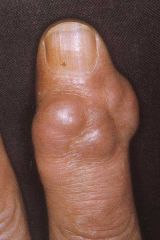![]()
![]()
![]()
Use LEFT and RIGHT arrow keys to navigate between flashcards;
Use UP and DOWN arrow keys to flip the card;
H to show hint;
A reads text to speech;
16 Cards in this Set
- Front
- Back
- 3rd side (hint)
|
Tumors and Tumor-Like Lesions of Joints
Ganglion cyst (bible cyst) |
•Small pseudo-cyst near tendon sheath, usually only removed if unsightly, limit motion, painful, synovial fluid filled. |

|
|
|
Tumors and Tumor-Like Lesions of Joints
Pigmented Villonodular Synovitis |
•Benign but locally invasive neoplasm; does NOT metastasize. 80% in knee, tendon sheaths. Surgical excision is curative. |
|
|
|
Tumors and Tumor-Like Lesions of Joints
Giant Cell Tumor of Tendon Sheath |
•Similar to above, but in wrist, fingers.
•Surgical excision, but tends to recur. |

|
|
|
Diseases of Skeletal Muscle
Major Determinants of Disease |
•Skeletal muscle is composed of cells that cannot regenerate.
•Muscles and their nerves operate as a unit (the motor unit).
•Normal function of the motor unit is dependent on the ability of nerve signals to cross the neuromuscular synapse. |
|
|
|
Diseases of Skeletal Muscle Major Determinants of Disease |
•Muscle sheath depends on its being connected to a functioning nerve. •Genetic defect may cause muscle disease •Autoimmune disease often affects muscle •Muscle is resistant to Infection |
|
|
|
Muscle Atrophy Neurogenic Atrophy (shrink upon denervation) |
•Type 1 and Type 2 fibers affected •Nerve injury, peripheral neuropathy (diabetes) |
|
|
|
Muscle Atrophy Disuse Atrophy |
•Bed rest •Immobilization (Ex: Stroke), corticosteroid therapy •Type 2 fibers affected (Don't use it you lose it) |
|
|
|
Muscle Atrophy Genetic Atrophy |
•Defect in SMN protein (Survival Motor Neuron Protein) Mu •Muscular Dystrophy |
|
|
|
Genetic Atrophy: Muscular Dystrophy (Atrophy, Weakness)
Duchenne muscular dystrophy |
•Genetic, absence of dystrophin protein in mucle cells |
|
|
|
Genetic Atrophy: Muscular Dystrophy (Atrophy, Weakness) Becker MD |
•Milder, dystrophin is present but abnormal |
|
|
|
Myositis and Myopathy
Polymyositis |
•Autoimmune. Dense infiltrate of inflammatory - cells (Lymphocytes) among muscle cells -High serum CK -T-cell damage
•Other Causes: -Viral Influenza (Common) -Bacterial Tetanus (Clostridium Tetani) |
|
|
|
Myasthenia Gravis |
•Motor Unit function decreases •Type 2 (auto-) immune reaction: cytotoxic hyerpsensitivity 1. Antibodies attach to target cell, which is destroyed by phagocytosis or Inflammation. 2. Antibodies attach to target-cell receptors and interfere with Target-cell function, as in the blockage of signal transmission from nerve to muscle in myasthenia gravis. |
|
|
|
Myositis and Myopathy (Non- Inflammatory)
Rhabdomyolysis |
•The sudden Necrosis of skeletal muscle, with release of large amounts of myoglobin into the circulation.
•Causes: -Statins, Crush Injury: (Non-inflammatory Rhabdomyolysis) |
|
|
|
Tumors and Tumor-Like Lesions of Soft Tissue
Lipoma |
•Benign fatty tumor (most common soft tissue tumor) -Liposarcoma: Malignant, deep, large, sluggish |
|
|
|
Tumors and Tumor-Like Lesions of Soft Tissue Fibroma |
•Collagen - producing benign tumor -Fibrosarcoma: Malignant, commonly around knee |
|
|
|
Tumors and Tumor-Like Lesions of Soft Tissue Malignant fibrous histocytoma (MFH) |
•Is most common soft tissue sarcoma in adults. Quite malignant, about half metastasize. Often Post-radiation therapy |
|

